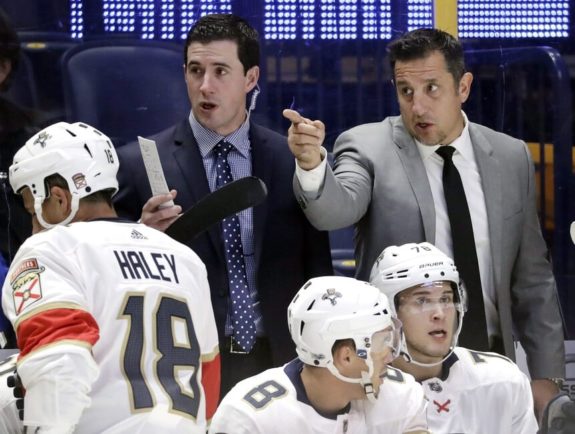In the 2017-18 season, Toronto Maple Leafs head coach Mike Babcock went the ‘spread the wealth’ route in regard to his power play units, much to the dismay of many Maple Leafs fans as the deadly Auston Matthews-William Nylander duo resided on the less-utilized second unit behind the likes of Tyler Bozak and James van Riemsdyk on the top group.
That said, Maple Leafs fans got their wish last season as Babcock loaded his top unit with the dealy fivesome of Matthews, John Tavares, Mitch Marner, Morgan Rielly and Nazem Kadri. Of course, with Kadri being dealt to the Colorado Avalanche, Marner without a contract as we sit in the first week of September, and some new additions to both the forward group and the blue line, the Maple Leafs’ power play units are vastly subject to change for the 2019-20 season.
Let’s take a look at what the Maple Leafs power play units should look like in their season-opener on Oct. 2 against the Ottawa Senators.
First Power Play Unit
Auston Matthews, John Tavares, Mitch Marner, Morgan Rielly, Andreas Johnsson
The Maple Leafs’ top power play unit in the 2018-19 season was unstoppable to begin the season. In October of 2018, the Maple Leafs’ clicked at a 32.3% clip on the man advantage, second only to the also-lethal top unit from the Washington Capitals. However, from Jan. 1 through to the end of the regular season, the Maple Leafs tied the Buffalo Sabres for 13th with a 19.8% success rate with the man advantage. While teams relentlessly studied tape of the Maple Leafs’ philosophy of working off of Mitch Marner on the right side and subsequently cut off passing lanes that looked too easy early in the season, the Maple Leafs’ man advantage scuffled down the stretch, especially given the level of talent on board.

However, at the end of the day, the Maple Leafs finished eighth in the league with a 21.8% clip on the man advantage, sandwiched between the Avalanche and Edmonton Oilers – two other clubs with superstar talent across their top power play groups. Of course fans want the Maple Leafs to be closer to the top three than the top 10, however, the power play was largely successful, and I doubt Babcock attempts to fix what mostly wasn’t broken.
Keep in mind that the Maple Leafs hired former Florida Panthers assistant Paul McFarland who ran the Panthers’ man advantage in 2018-19, a group that quietly finished second in the NHL with a 26.8% success rate on the man advantage. Whether the 33-year-old McFarland can help the Maple Leafs’ power play remains to be seen, but it’s no secret as to why he was a top target of Babcock, general manager Kyle Dubas and the rest of the club’s front office.

Assuming a Marner contract is completed in time for opening night, expect the Maple Leafs’ ‘Big Four’ of Matthews, Tavares, Marner and Rielly to remain on that top unit. The only newcomer should be sophomore Andreas Johnsson. Johnsson saw action on the Maple Leafs’ top power play during last season’s first-round playoff series against the Boston Bruins during Kadri’s suspension. He logged 1:53 of power-play time per game in the seven-game first-round series, an increase on his 1:35 from the regular season and the fourth-most among Maple Leafs’ forwards not named Kadri.
As a result, it would appear Johnsson is the logical fit to take over Kadri’s net-front/high-slot presence on the Maple Leafs’ star-studded top power play lineup in what should be a career-season for the 24-year-old. After all, he did enjoy some success in that spot when the team needed it the most.
Expect the Maple Leafs to continue to load their top unit with the most talent possible. Along with heavy input from the proven McFarland behind the bench, perhaps we can anticipate increased power play success in the 2019-20 campaign.
Second Power Play Unit
Alexander Kerfoot, William Nylander, Kasperi Kapanen, Tyson Barrie, Jason Spezza
The second unit is where the most change will take place as three newcomers are expected to get power play reps with the blue and white next season.
The one lock of the listed five skaters for this unit is Barrie. Among defensemen over the last two seasons, only John Carlson and Keith Yandle have more than the 55 power play points Barrie has racked up on the man advantage. Barrie anchored a star-studded power play cast that included MVP-caliber players Nathan MacKinnon and Mikko Rantanen while with the Avalanche, however, it’s difficult to see him supplant Rielly on Toronto’s top unit given the latter’s career-best season while quarterbacking that group last season. As a result, expect Barrie to anchor the Maple Leafs’ second unit.

Veteran Jason Spezza was brought into the fray this offseason for many reasons including leadership, experience and his ability in the faceoff circle. However, he was also brought in with the expectation that he will contribute to the Maple Leafs’ second power play unit. Despite tallying just 53 points over the last two seasons in Dallas, he recorded 23 of those points on the man advantage. He’ll certainly be a part of this group.
After the quartet of Matthews, Tavares, Marner and Johnsson, the trio of Kapanen, Kerfoot and Nylander represent the best remaining offensive talent on the team. Kerfoot was, at times, part of Colorado’s top power play unit last season. He could also complement Spezza and take faceoffs on his back-hand side as he went 56% in the faceoff dot last season with Spezza winning draws at a 58.2% clip. As with any power play, the hope here is the Maple Leafs can win the ensuing faceoff after a penalty call and control the puck from there.
Nylander and Kapanen are both lethal shooters, especially the former. Nylander has the ability to distribute the puck with elite vision – which makes him a good fit alongside Matthews at even strength – but he’can also pick corners with that deadly wrister with the best of them.
Kapanen’s elite speed and agility lends itself better to a transition-type game rather than a five-man power play set up, however he too possesses a dynamite release. After spending much of the 2018-19 season on the second power play, we can certainly expect to see him again there this time around.
With the star-level talent on both units, we can expect the Maple Leafs to enjoy plenty of success on the power play in 2019-20. With the addition of power play guru Paul McFarland to the coaching staff, we can also expect to see some additional strategies used in the setup or zone-entry. Whatever the case, Maple Leafs fans should be in some entertaining man advantage action for the blue and white again this season.